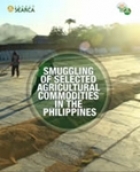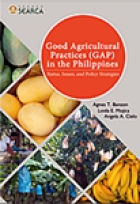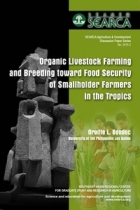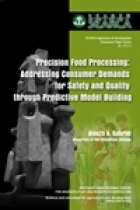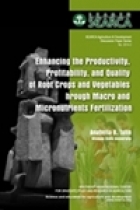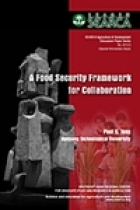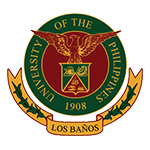SEARCA Publications
Meta-analysis of SEARCA's Food Security Initiatives
Dinah Pura T. Depositario, Henry M. Custodio, Bessie M. Burgos
This monograph highlights the findings of the meta-analysis on SEARCA’s food security-related initiatives from 2000 to 2012. It draws insights from the output of the initiatives; and identifies the gaps in SEARCA’s food security-related research, capacity development, and knowledge management initiatives.
2015Monograph
Smuggling of Selected Agricultural Commodities in the Philippines
This paper was prepared by the Southeast Asian Regional Center for Graduate Study and Research in Agriculture (SEARCA) as a milestone deliverable of the project funded by the Department of Agriculture Bureau of Agricultural Research (DA-BAR) titled, An Assessment of Smuggling on Selected Agricultural Commodities in the Philippines. Through Focus Group Discussions (FGDs) and Key Informant Interviews (KIIs) done in various institutions (in the Philippines and its neighboring countries)…
2014Policy Paper
Good Agricultural Practices (GAP) in the Philippines: Status, Issues, and Policy Strategies
Agnes T. Banzon, Loida E. Mojica, Angela A. Cielo
This study was undertaken to assess the status of Good Agricultural Practices (GAP) adoption in the Philippines in relation to two of the country’s top export fruit crops: Cavendish banana and Carabao or Super Manila mango. Specifically, the study aimed to identify the drivers of and constraints to GAP adoption in the country, with the end goal of crafting policy strategies to enhance adoption for the two identified commodities in the study. Davao was selected as the study area for banana…
2013Monograph
Estimating the Demand Elasticities of Rice in the Philippines
Flordeliza A. Lantican; Mercedita A. Sombilla; Karen P. Quilloy
Rice remains the basic staple food in the Philippines. For most Filipinos, no meal is complete without rice. It is their main source of carbohydrates and energy and provides a physiological sensation of satiety. It accounts for 20 percent of their daily household budget. Demand for rice has strengthened over time in the country. While the demand theory states that as income rises, food intake becomes more diversified usually away from the basic staple, e.g., rice and corn in the case of the…
2013Monograph
Strengthening Markets of High Value Fruits and Vegetables in Mindanao: The Case of Transport and Shipping Service Improvement
Gilberto M. Llanto, Mercedita A. Sombilla, Karen P. Quilloy, and Francis Mark A. Quimba
This monograph that highlights the important role of transport and logistics in contributing to agricultural competitiveness in Mindanao, Southern Philippines. This monograph presents the findings of the project titled “Transport Policy Study: Promoting Efficiency and Productivity of Flow of Goods - A Focus on the Transportation Needs of Mindanao Region,” funded by the Australian Centre for International Agricultural Research (ACIAR). The study analyzed the factors that contribute to high…
2013Monograph
Organic Livestock Farming and Breeding toward Food Security of Smallholder Farmers in the Tropics
Orville L. Bondoc
Organic livestock farming, while not the only solution to food security challenges, offers great potential in addressing many specific concerns in food production through a more sustainable farming system that may support the rural economy with special relevance to smallholder farmers. Organic livestock farming involves innovations that will improve farm productivity, household incomes, and food security. For instance, the use of adapted local (indigenous) breeds in smallholder organic…
2015Discussion Paper Series, No. 2
Precision Food Processing: Addressing Consumer Demands for Safety and Quality through Predictive Model Building
Alonzo A. Gabriel
Due to the aggressive campaigns of the industry and the government, consumer preferences have already been shifting toward healthier food products that are minimally processed and with optimal fresh quality. In a study conducted by the Food Marketing Institute (FMI) in the United States 1n 2008 and 2009, almost half of the conumers surveyed (41%-46%) stated that they would buy products that will cater to their health and welness needs (Sloan 2010). The beneficial effects of consuming fruits and…
2014Discussion Paper Series, No. 3
Enhancing the Productivity, Profitability and Quality of Root Crops and Vegetables through Macro and Micronutrient Fertilization
Anabella B. Tulin
This paper presents various studies on the effects of macro- and micronutrient fertilization on the productivity (growth and yield), profitability, and quality of root crops such as purple yam (Dioscoreaalata) and sweetpotato (Ipomoea batatas),1 and vegetables such as tomato (Lycopersicon esculentum), pechay (Brassica napus), and cabbage (Brassica oleracea). Most of the results presented here were taken from the findings of various research projects conducted by the author. Some of these…
2014Discussion Paper Series, No. 2
SEARCA Research Thrusts and Programs through the Years: The Way toward Food Security
Dinah Pura T. Depositario, Gil C. Saguiguit, Jr.
The paper describes the evolution of SEARCA research thrusts and programs from 1969 to the present. SEARCA’s research projects underwent a paradigm shift in terms of the level of integration of disciplines among the researches—from discipline-based to multidisciplinary to interdisciplinary and more recently, transdisciplinary researches. The paper also analyzed how food security was mainstreamed in SEARCAresearches through the years. The period from 1969 to 1979 can be described as the…
2014Discussion Paper Series, No. 5
A Food Security Framework for Collaboration
Paul S. Teng
Food security is fundamental to human security and sustainable development. The global food crisis in 2007–2008 highlighted the point that food insecurity threatens peace and stability, and is a key cause of conflict and possible violence. In Southeast Asia, food security is an overriding concern as it is affected by short and long term factors, key among which are increasing food demand due to population growth, changing patterns of food consumption arising from rapid urbanization, decline…
2013Discussion Paper Series, No. 5

